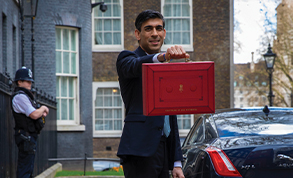Chancellor increases efficiency requirement
 As he prepares to deliver his spring statement on 23 March, chancellor Rishi Sunak (pictured) announced he would lead a drive on efficiency and value for money. He will chair the new Efficiency and Value for Money Committee that will oversee the delivery of the 5% (£5.5bn) cross-Whitehall efficiency target set in last year’s spending review.
As he prepares to deliver his spring statement on 23 March, chancellor Rishi Sunak (pictured) announced he would lead a drive on efficiency and value for money. He will chair the new Efficiency and Value for Money Committee that will oversee the delivery of the 5% (£5.5bn) cross-Whitehall efficiency target set in last year’s spending review.
Mr Sunak said the NHS efficiency commitment will double to 2.2% in 2022/23 – freeing up £4.75bn over the next three years. However, the practical implications of the announcement are unclear.
The national tariff consultation, which ends this week, proposes a 1.1% efficiency factor is used for setting national and unit prices for 2022/23. This efficiency level would inform the fixed element in the new aligned payment and incentive system used to fund NHS providers. And it would also impact on the variable element used to promote elective recovery – remunerating trusts for additional elective activity above planned levels.
Allocations for clinical commissioning groups and systems have also been informed by a 1.1% efficiency requirement. However, in reality, NHS bodies face efficiency requirements far in excess of 1.1%, even before concerns about rising inflation are taken into account. And the change in the national efficiency requirement may simply be a recognition of this fact.
In today’s announcement, the chancellor said the NHS savings would be made through a range of programmes, including digitisation of diagnostic and other frontline services. This could cut cost per admission by up to 13%. The efficiency of surgical hubs would be improved, while digital tools to reduce staff time spent on admin would be developed.
A cross-government review of arm’s length body spending will seek to find savings of at least £800m.
‘During these challenging times it’s vital that every single penny of taxpayers hard-earned cash is being spent well,’ Mr Sunak said. ‘The current level of waste across government is simply not acceptable – which is why we’re doubling down on wasteful spending and launching an efficiency drive to make £5.5 billion worth of savings.
‘That money will then be pumped directly into the world class public services that the British people deserve.’
Saffron Cordery, deputy chief executive of NHS Providers, said trusts were working hard to reduce costs and find efficiencies. She added: ‘Even before this announcement, many were concerned about the scale of savings they would be expected to make in the coming financial year, especially given the need to tackle care backlogs, meet rising demand for services and deal with the ongoing impact of Covid-19 at a time of widespread workforce shortages.’
Ms Cordery said recent inflationary pressures including energy and fuel costs could make the higher savings requirement more stretching.
The Institute for Fiscal Studies (IFS) said the outlook for inflation had changed substantially since the NHS settlement was agreed. Updated forecasts for the GDP deflator (the measure of inflation in the public sector) are due this week. But, based on changes in another inflation measure, consumer price index (CPI), IFS senior research economist Ben Zaranko said the real-terms growth in NHS England's resource budget could drop from 8.6% to around 6% in 2022/23.
The Bank of England has warned inflation could hit double figures later this year, but much would depend on how the Ukraine conflict affects oil, gas and food prices. But it was unlikely the chancellor would look again at the NHS settlement.
‘The NHS is only one of many areas being squeezed by higher inflation and perhaps unlikely to be at the top of his list of priorities,’ Mr Zaranko said.
‘Things like supporting households with energy bills, or topping up the defence budget, would probably come first. The Treasury may also be reluctant to re-open a settlement agreed just six months ago, especially when the NHS budget will still grow at a healthy rate even after accounting for higher inflation. It would probably also make sense to wait the outlook for inflation is clearer and until pay settlements have been agreed. So I wouldn't rule out top-ups in the autumn.’
Related content
The value masterclass shares examples of organisations and systems that have pursued a value-driven approach and the results they have achieved.
This webinar series offers colleagues of ICS organisations the opportunity to discuss common priorities, challenges, and successes within their field.